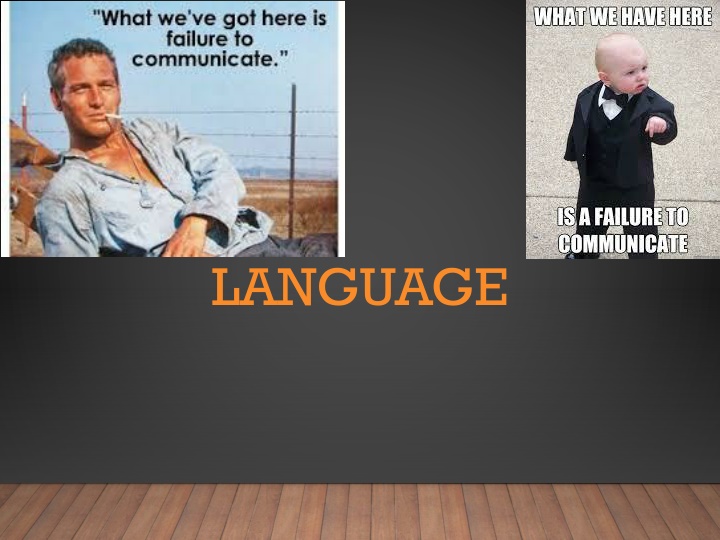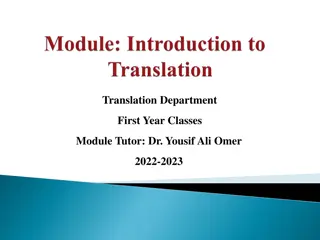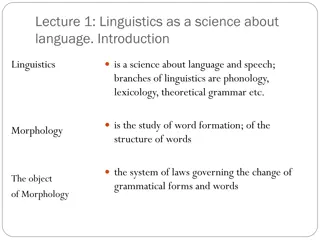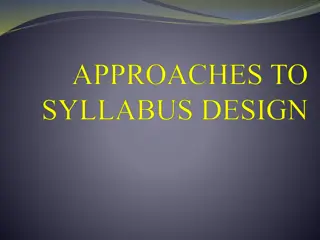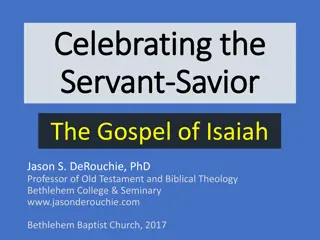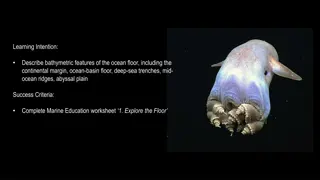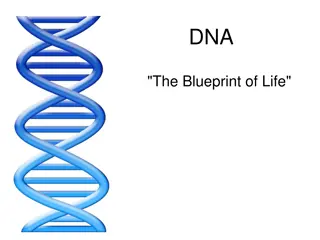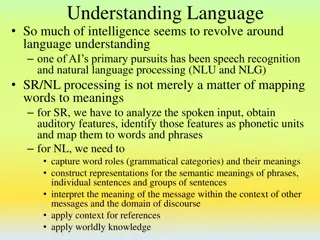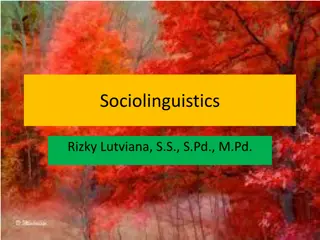Unraveling the Depths of Language Structure
Delve into the intricate structure of language, exploring its universal truths, critical features, and building blocks. Discover the complexities of phonology, morphology, syntax, and discourse, and analyze language behavior at multiple levels. From distinguishing language from communication to discussing language learning by non-human primates, embark on a journey to unravel the richness of linguistic behavior and cognition.
Download Presentation

Please find below an Image/Link to download the presentation.
The content on the website is provided AS IS for your information and personal use only. It may not be sold, licensed, or shared on other websites without obtaining consent from the author.If you encounter any issues during the download, it is possible that the publisher has removed the file from their server.
You are allowed to download the files provided on this website for personal or commercial use, subject to the condition that they are used lawfully. All files are the property of their respective owners.
The content on the website is provided AS IS for your information and personal use only. It may not be sold, licensed, or shared on other websites without obtaining consent from the author.
E N D
Presentation Transcript
OUTLINE: LANGUAGE 1) Distinguish between language and communication. 2) Discuss the hierarchical structure of language. 3) Examine a variety of approaches aimed at understanding and predicting linguistic behavior: Speech perception Speech production Syntax Chomsky s Tranformational Grammar Pragmatics 4) Re-visit the nature vs. nurture debate as it related to language learning. 5) Discuss language learning by non-human primates.
DEFINING LANGUAGEIS HARD Language is very difficult to put into words. ~ Voltaire Language is a system of symbols that individuals use to communicate ideas or feelings to one another a rule-governed use of arbitrary symbols. a shared symbolic system for communication Language is not synonymous with communication!!!
UNIVERSAL TRUTHS AND CRITICAL FEATURES Universal truths: Universal 1st Language learning is seemingly effortless Infants distinguish phonemes of all languages _________________________________________________________
UNIVERSAL TRUTHS AND CRITICAL FEATURES Critical features of Language 1. Semanticity / communicativity 2. Productivity/generativity 3. Arbitrariness 4. Structure 5. Displacement 6. Dynamic 7. Traditional Transmission
BUILDING BLOCKS OF LANGUAGE: I 1. Phoneme categorical change based on context 2. Morpheme smallest unit of meaning, e.g., truckers content vs. function tense, number, possession, comparison 3. Words contentives and functors 4. Parts of speech
BUILDING BLOCKS OF LANGUAGE: II 5. Phrase subject, verb, object 6. Sentence Positive vs. negative True vs. false 7. Discourse Speaking roles
ANALYZING LANGUAGE AT MULTIPLE LEVELS My friend Pete stole the little boy's rocks and put them under his towel. My friend Pete stole the little boy's towels and put them under his rock. Phonology Phonemes - deleting phonemes Morphemes - speech errors Syntax Words - lexical access (TOT) Parts of Speech - anaphor resolution Phrase - expectations/comprehension
ANALYZING LANGUAGE AT MULTIPLE LEVELS My friend Pete stole the little boy's rocks and put them under his towel. My friend Pete stole the little boy's towels and put them under his rock. Semantics Sentence - words v structure Pragmatics Discourse - audience factors
PHONOLOGY: SPEECH PERCEPTION Size of phoneme set: English Hawaiian African languages 40 phoneme 15 phonemes 60 phonemes Phonology rules for combining phonemes EX: Squirrel (let s be fair) Co-articulation phonemes are blended in speech telephone operator Problem of invariance
PHONOLOGY: SPEECH PRODUCTION Allophones slightly different articulations of the same sound "Please put the paper cup to your lip" foreign language perception regional differences in English
IS SPEECH PERCEPTION DIFFERENT? YES! EXTREME fluency 50 phonemes/second; 50 times faster than non-speech stimuli Categorical Perception /ba/ vs. /pa/ Voice Onset Time pit vs. bit
COGLAB: CATEGORICAL PERCEPTION 10 9 8 7 Frequency 6 BA PA 5 4 3 2 1 0 Ba1 Ba2 Ba3 Ba4 Ba5 Ba6 Ba7 Ba8 Ba9
IS SPEECH PERCEPTION DIFFERENT? NOT SO MUCH Categorical perception of non-speech stimuli Time perception Color Emotional expressions Context effects phonemic restoration effect phonemic refinement (Deutsch demo) REM effect ______________________________________________________ Compromise position: modularity
SYNTAX: THE STUDY OF GRAMMAR Prescriptive grammar what your HS English teacher tried to teach you Descriptive grammar the rules that govern legal English utterances
SYNTAX: THE STUDY OF GRAMMAR Which of these sentences use proper English syntax? 1) The students bought the book. 2) Bought the book. 3) Bought the student the book. 4) The book was bought by the student. 5) By whom was the book bought? 6) By student the book bought. 7) The student was bought by the book. 8) Who bought the book? 9) The book bought the student. 10)The book bought.
SYNTAX AND SEMANTICS Semantics how do we express meaning through language? Speech errors - in-class confusions, maintain morphemes Right- and left-branching languages He bought the book at the store. vs. He bought at the store the book.
SYNTAX AND SEMANTICS Lexical entries include syntactic information Objects can have different roles Agent Patient Beneficiary indirect recipient of an action Instrument means used to implement it doer of an action receiver of an action Mary and John saw the mountains flying to California
LINGUISTIC RELATIVITY / WHORFIAN HYPOTHESIS Strong Version language determines thought Weaker Version language influences thought. NewVersion language obligates us to entertain certain thoughts.
LINGUISTIC RELATIVITY / WHORFIAN HYPOTHESIS Data tossed around as evidence: Inuit language has 100 different words for snow . Cross-cultural differences in color words Languages that like counting or timing words. There are 53 people on the boat but only enough lifeboats for 36. Not unaware of the passing of time. Marked/Unmarked terms In English: Belief/Disbelief In German: Doch vs. Doch stimt. Issues of translation Die brucke (f) vs. el puente (m) My North foot
SYNTAX AND SEMANTICS: CONFUSION REIGNS The horse raced past the barn fell. The florist sent the flowers was very pleased. The old train the young. ______________________________________________ Garden path sentences - these sentences are hard because the form of the sentence creates expectations that are not met.
CHOMSKYS TRANSFORMATIONAL GRAMMAR A panda walks into a bar Shallow Structure The words used to express an utterance Deep Structure What those words actually mean Why is the distinction important? Word order makes a difference The French bottle smells good. The French bottle good smells.
CHOMSKYS TRANSFORMATIONAL GRAMMAR Shallow structures are often ambiguous I saw a man eating fish. The spy saw the cop with binoculars. The Mayor ordered the police to stop drinking. Librarian: Shh!! The people around you can't read. Student: Then what are they doing in a library. ( )vs Sx ( ) 2 S x2
DO WE EVER REMEMBER THE SHALLOW STRUCTURE? Jokes, personal statements, and insults Why? Because exact wording matters Rhythmic speech Rubin (1977) memory for 23rd Psalm, National Anthem, Preamble Why? Rhythmic structure gives you an opportunity to restart at the next rhythmic juncture
DO WE EVER REMEMBER THE SHALLOW STRUCTURE? Song lyrics and counting-rhymes Why? Integrated levels of multiple constraints Friend of the Devil I've got two reasons why I cry away each lonely night, The first one's named Sweet Anne Marie and she's my heart's ____________. The second one is prison babe, and the Sheriff's on my trail, And if he catches up with me I'm gonna spend my life in _________________.
PRAGMATICS: HOW WE EXPRESS OUR THOUGHTS Surface structure changes dramatically (and spontaneously) depending on the audience s Age Native language Social Standing Relationship Setting
PRAGMATICS: HOW WE EXPRESS OUR THOUGHTS The musicality of speech Prosody pitch variations in speech including tonal languages Cadence the timing of speech utterance (stressed v unstressed syllables) Both have implications for meaning Difference between different languages
LANGUAGE LEARNING: NATURE V. NURTURE 1. Imitation However, never would hear "goed"/"buyed" Babbling closely tied to native language Parents speak differently to girls than boys and girls develop language earlier 2. Learn a set of rules What is the plural of "wuk"? What is the plural of "wug"? 3. Behaviorist Account rewarded for sounds that approach real words Abby s first word was Dada
LANGUAGE LEARNING: NATURE V. NURTURE However, not good at explaining grammar mothers correct errors of fact; Nobody don t like me. generalize to novel situations generate/understand novel utterances
SAFFRAN, ASLIN, & NEWPORT (1996): INTRO Theoretical Question: Empirical Question: Intro: What is the evidence of experience-independent learning? Experience dependent learning? Why is language segmentation a difficult problem? What are transitional probabilities?
SAFFRAN, ASLIN, & NEWPORT (1996): METHOD Method: Why did they use synthesized speech? Words: tupiro/golabu/bidaku/padoti Transitional probabilities? E1 Test: tupiro vs. dapiku E2 Test: tupiro vs. rogala or bubida
SAFFRAN, ASLIN, & NEWPORT (1996): RESULTS AND DISCUSSION Results:Listened longer to: Implications/Questions: 1. What did Exp 2 accomplish that Exp 1 did not? 2. How do infants learn vocabulary? 3. Is this type of learning completely experience-based? 4. What are the other types of cues that Saffran, et al. (1996) allude to in the penultimate paragraph? 5. Why did the authors use a habituation procedure? Do you have any concerns about this methdology? ___________________________________________________ Aside: Better with foreign language than nonsense
LANGUAGE LEARNING: NATURE V. NURTURE 1) Cultural Universals Progress very similar across cultures Girls hit major milestones before boys do (could be genes) 2) Cooing sounds the same across cultures and even in deaf children deaf children don t babble 3) Infant phoneme recognition Through at least 6 months, all phonemes are distinguishable Japanese kids lose /l/ vs. /r/ English kids lose allophones of /t/ 4) Subject-Verb-Object Order OVS and OSV never used
LANGUAGE LEARNING: SENSITIVE PERIODS Definition Plasticity confined to a restricted period Learning is irreversible children denied speech (Genie) 2nd language learning Adults learn faster but rarely gain same level of proficiency early vs. late learners of sign language Cortical organization of L1 and L2
LANGUAGE LEARNING: SENSITIVE PERIODS Why do sensitive periods occur? By-product of specialization Cortical areas respond to wide-range of stimuli Slowly become specialized When specialization is complete, critical period closes EX: Raising animals in the dark
NATURAL LANGUAGE IN NON-HUMANS Semanticity Chimps make different sounds for different predators Flexibility Animal communication is not dynamic But, whales change calls after exposure to other pods. Limited Scope No signal for trees, different fruits, emotions Displacement and Productivity Let me tell you about the snake I saw yesterday Whew, glad that wasn t an eagle No eagles anywhere in sight
NON-HUMAN LANGUAGE LEARNING Speech Primates no. Birds maybe? (see also this and this) Washoe s impressive sign language ability: By age 1, she could combine signs "more fruit" "open out please hurry By age 4, she understood 160 signs Creative use of language Gardners fridge = "cold box" Washoe fridge = "open food drink
NON-HUMAN LANGUAGE LEARNING But: By age 4, a child knows 20x as many words Utterances never averaged more than 1-2 morphemes; Child by age 3 averages 4 morphemes per utterance Elementary Constructions
